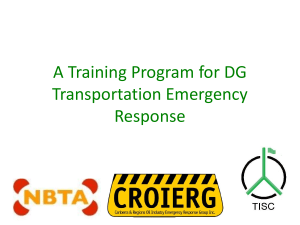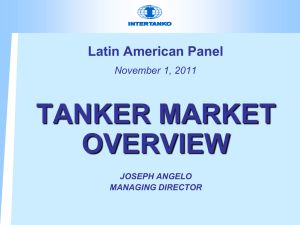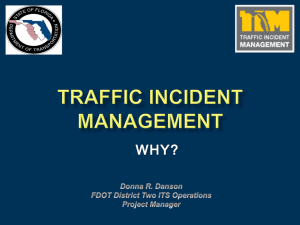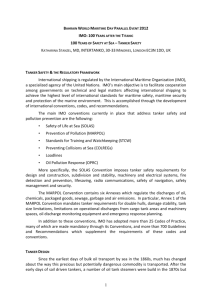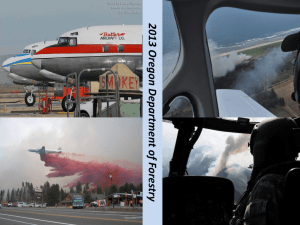NBTA Bulk Tanker Day TISC Training
advertisement
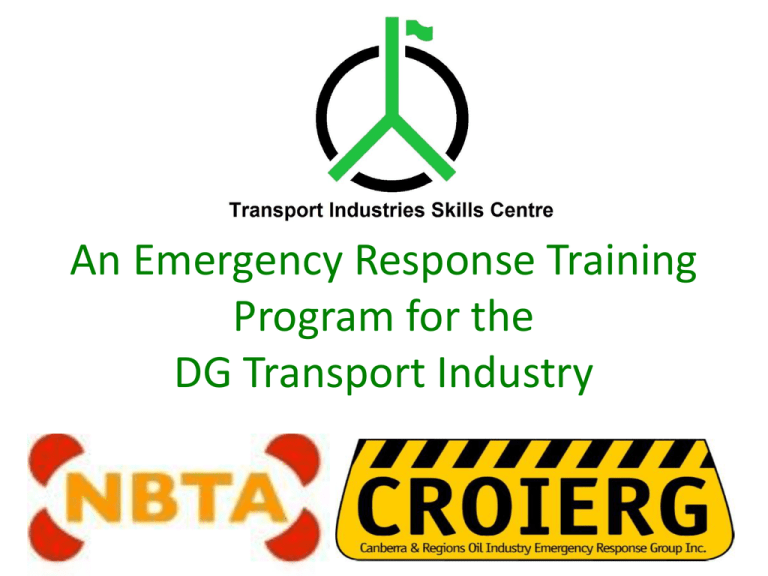
An Emergency Response Training Program for the DG Transport Industry Legal Requirement If your company transports dangerous goods there is a legal requirement (part 14.2.2 DG regulations) for you to: 1. Have a Transport Emergency Response Plan that works. (TERP) 2. Ensure that all staff involved in the TERP are competently trained. (Also has some WHS implications). 3. In line with NTC/Australian Transport Council Guidelines, you must exercise that TERP and update it once per year. 4. To assist with these obligations, the industry has developed a program for DG Transport Companies. The Program • Identified as a need both by industry and emergency services. • Training Program built on nationally recognised industry standards and industry best practice that delivers nationally recognised qualifications. • Developed in close consultation with industry experts. • Has ultimately led to the implementation of the “Bulk Tanker Emergency Responder Card” issued by Fire Protection Association Australia (FPAA) • Supported by Emergency Services, the Australiasian Fire and Emergency Services Authorities Council (AFAC) and Industry Bodies. Program Structure Currently there are 3 ways in which qualifications can be achieved •Option 1 – “3 Day Responders Course” Deals with topics such as : •understanding your company’s transportation emergency response plan (TERP) •providing information about company vehicles during emergency incidents •providing information about dangerous goods during emergency incidents •understanding your role during an emergency incident •planning your response and consulting with Emergency Services •conducting recovery operations at the site •conducting the initial clean up Targeted at first responders and those who deal with the incident at the site. Delivers qualification in “Dangerous Goods Road Transport Emergency Recovery Operations” Program Structure • • Option 2 – “5 day Manager/Responder Course” Same as responder for first 3 days then 2 day workshop for managers that deals with emergency response management from the companies/managers point of view, including: • hazmat plans and emergency response arrangements • incident management principles and systems • converting information into intelligence and effective action • the emergency planning process • Developing and documenting a TERP • developing and conducting emergency exercises • training your staff and contractors about TERPs Delivers qualifications in “Dangerous Goods Emergency Response Management” and “Dangerous Goods Road Transport Emergency Recovery Operations” Both Option 1 and 2 also provide an opportunity to apply for Bulk Tanker Emergency Responder Card” Program Structure Option 3 – “3 day stand alone Managers course” Deals with the same topics as in Option 2 however needs to also include some topics from option 1 Delivers qualifications in “Dangerous Goods Emergency Response Management” Requires post course work to be done in the workplace and through assessment portfolio. Does not provide opportunity to apply for responder card. Relies on the manager to be very self directed and motivated to continue once returned to the workplace Option 1 and 2 are assessed at time of course. Option 3 is assessed post course. Industry Accredited Responder Card • Able to apply for industry accreditation through MPAA Successful Completion of Option 1 or option 1 & 2 also have at least 1 manager who has completed Option 1 & 2 of the program, $20 million insurance and sign code of conduct). • Recognised by Fire Authorities that formal training has taken place. Drivers Each incident will have its own unique characteristics If able: • Contact Emergency Services by telephone – 000. • Notify company Manager, Scheduler or Controller. • Provide minor traffic management (within reason) • Identify possible hazards. (within reason) • Provide information to Emergency Services re: Consignment Notes/Licence details/EPG (emergency procedure guide) etc. Prime Mover Battery Isolation Switch. Engine Shutdown Switch. Emergency Procedure Guide. Tanker Construction • Tanker compartments and volumes. • Construction Materials • Not all tankers can be uncoupled when loaded. Tanker Construction Petroleum Tanker Fittings • • • • • Bottom loading tanker fittings. Top loading tanker fittings. Tank fittings including Vents, Probes, Valves, product indicators & Emergency Information Panels. Petroleum Tanker Fittings Going to the incident • • • • • • What intelligence do you have? What resources will you need? What clothes will you take. Food, Water etc How long is it going to take you? How will you gain Access? (police perimeter, traffic etc) Safety equipment and PPE • Torches, phones, cameras, ohm meters etc • Basic PPE • Other ignition sources eg radios, matches, cigarette lighters etc Emergency Services • Primary objective is safety including: – Hot Zones, Warm Zones,Cold Zones, Setting Perimeters – Monitoring safety of personnel at the scene – The safety of public and community at large – Monitoring environmental conditions at the scene, ie gas, air quality etc. Safety at the Incident • Contact Emergency Services and identify yourself and your team. • Primary objective is to provide assistance to Emergency Services. (Incident Commander) • They can give you vital info. • Develop a site action plan including – Identification of potential hazards, how to recover product safely, initial environmental control plan. Environmental Considerations • Objective is to have as little impact on the environment as possible. • Control by understanding the environment and applying appropriate measures such as: – Stemming product flow where possible by addressing minor leaks from hatches, vents etc – Weather conditions – Placing booms in the correct locations, pits, Earth/sand banks etc – Calculating water flow in creeks, drains etc Product Recovery Considerations • Safest way possible. • Static Electricity and the necessary precautions. • Recovery Equipment including: – Fittings, hoses, pumps, compressors, earthing rods and leads, • Tools such as: – Ohm Meters, Air Hoses, Drills, Hole Cutters, • Access to the product and how to decant. Safety when Transferring • Constant communication with Emergency Services (They are in control) • No ignition sources (lighters, phones torches etc) • Receiving tanker has capacity and is able to receive that type of product. (switch loading) • All cam lock fittings taped • All components earthed and tested • All hoses drained at end of pumping Questions Time permitting: • Small break. • Outside to view response trailer and equipment excercise
